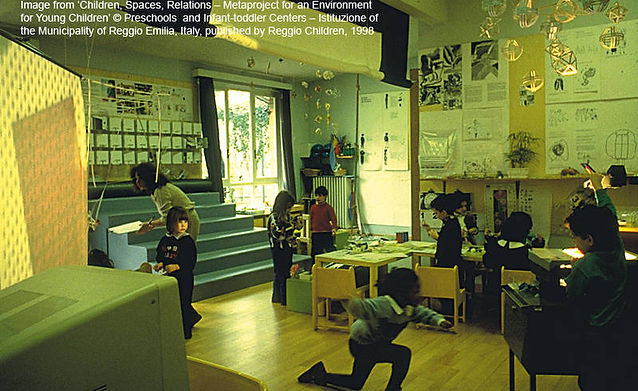What Is a "Big Idea"?
3.Explore big ideas and expand professional knowledge by creating a utopia thinking pattern
Big Ideas


When exploring with different coloured paddles and light, Miss M and child D took turns shining a flashlight through the paddles. They discovered that when the light is shone through the paddles, the color of the light changed!
"The colors were very pretty!"
What are the big ideas that lie beneath the experiment with light, reflection and color? Can educators make connections to create a meaningful and integrated constructivist curriculum (Chaille, 2008)?
The focus of big ideas has a basic foundation in constructivism, which is influenced by the work in preschool centers of Reggio Emilia. “The core value I hold is that children are competent, confident, curious theory-builders, this value is the essence of constructivism (Chaille, pp. 3, 2008)”. This value is deeply exemplified in the schools of Reggio Emilia. A constructivist teacher weaves threads through childrens experiences which can be connected to curriculum activities (Chaillie, 2008). This demonstrates how their world can be woven together, as they are provided with opportunities to connect a variety of interesting things and create more meaningful ideas and expereinces (Chaille, 2008).
Chaille, C. (2008). Constructivism across the Curriculum in Early Childhood Classrooms: Big Ideas as Inspiration. Boston, US: Pearson Education, Inc.
Three essential concepts for understanding big ideas: Inspiration, Connection, Observation (Chaillie, 2008).
Inspiration > Where do ideas come from? How do children and educators explore with each other to uncover ideas and topics that can lead to interesting and meaningful learning experiences? Inspiration is what leads individuals to discover new ideas and to accept what is already in front of them (Chaillie, 2008). When focusing on “big ideas,” the attention is directed towards what children deeply engage in. These big ideas will be inspirational to educators, which will stimulate the development of other big ideas that could be a basis for curriculum development (Chaillie, 2008).
Connection> Learning occurs when connections are made between the relationships of a variety of different things that are experienced and learned (Chaillie, 2008). The importance of connection, means that in addition to appreciating in the moment experiences, educators need to be aware of the connections between what children do and what they learn. Connections occur naturally for children, as they are constantly determined to make sense of everything they learn and experience (Chaillie, 2008). When focusing on connections, educators are valuing what children do naturally (Chaillie, 2008).
Observation> This concept involves participation and reflection and how an educator creates a constructivist curriculum. How do adults understand the world as the child is continuously constructing their understanding of it (Chaillie, 2008)? Educators focus their attention on how to observe children, and also how to create opportunities where childrens learning is “made visible” (Chaillie, 2008). Observations are considered an art and a science, which are a necessity for teaching and learning. However, traditional observations involve stepping back in order to fully appreciate what children are doing. “Making learning visible,” implies the teachers’ active participation in discovering what the children are thinking and experiencing (Chaillie, 2008).
Chaille, C. (2008). Constructivism across the Curriculum in Early Childhood Classrooms: Big Ideas as Inspiration. Boston, US: Pearson Education, Inc.

Link to Diane Kashin and Louise Jupp's blog entitle: "Big Ideas: Loose Parts…the Beautiful Stuff of Childhood"


Professor Louise Jupp commented on Diane's reflection on Big Ideas, stating that loose parts are a philosophy that guides her practice.
http://tecribresearch.wordpress.com/big-ideas/
The Philosophy of Frances and David Hawkins:
Frances and David Hawkins were husband and wife who worked collaboratively, as Frances was a teacher and David was an educational philosopher. Frances had a profound passion for deeply observing childrens learning processes. David developed a philosophy of education based on his wife's observations and writings, which ranged from details regarding the adult and child learning relationships to the public education policy. Their work has informed a generation of education experts and programs across the world (Hawkins Learning Center, 2012).
Most of David’s writings were based on a few central beliefs, which embraced his passion for curiosity-based learning, how children learn best when following their natural curiosities, how adults can engage in learning experiences with children and why it should be valued and supported by the educational system (Hawins Learning Center, 2012).
“Messing About in Science: Making Visible the Thinking and Ideas of David and Frances Hawkins”
The Process of Messing About!


These images are from Diane Kashin and Louise Jupp's blog article titled, "Announcing the Canadian Opening of the Exhibit Cultivate the Scientist in Every Child: The Philosophy of Frances and David Hawkins: An Interview with Dr. Ellen Hall".


Diane Kashin and Louise Jupp have had many experiences with the "Messing About" exhbits, to honor the big idea focus and invite others to understand the philosophies and ideas of Frances and David (Technology Rich Inquiry Based Research, 2013).
http://tecribresearch.wordpress.com/2014/02/10/the-big-ideas-of-messing-about/
 Messing About: rocks & balance |  Messing About: light-prisms |
|---|
Diane and Louise provided invitational provocations and questions, which were placed in the exhibit, around the messing about materials. This was done in hopes to spark further exploration with the materials (Technology Rich Inquiry Based Research, 2013).
http://tecribresearch.wordpress.com/2014/02/10/the-big-ideas-of-messing-about/





Messing About with light
Rocks
Balance


When messing about, big ideas of teaching and learning develop. Some of these big ideas are expressed below by David Hawkins (Technology Rich Inquiry Based Research, 2013)!
Retrieve the link to be directed to Diaine and Louise's article on, "The Big Ideas of Messing About".
http://tecribresearch.wordpress.com/2014/02/10/the-big-ideas-of-messing-about/



Utopian Thinking
U·to·pi·a> yo͞oˈtōpēə/
"An imagined place or state of things in which everything is perfect."

What is your idea of a perfect world?

According to Dahlberg and Moss, utopian thinking provokes and enables individuals to critique the status quo. Utopian thought and action provide a direction for radical change, in hopes to reconstruct the future (Dahlberg & Moss, 2005). To create transformative change, individuals must have open space to experiment, research, reflect and evaluate. One must be willing to act, with a vision to “deconstruct the present and reconstruct the future (Dahlberg & Moss, pp. 179, 2005).”
Dahlberg, G., & Moss, P. (2005). Ethics and Politics in Early Childhood Education. United States and Canada, NY: RoutledgeFalmer.

The municipal preschools in Reggio Emilia are involved in a process of Utopian thought and action. In some cases, this process has expanded over many decades, as thoughts and actions have developed through reciprocal relationships and new perspectives, which are obtained from border crossing (Dahlberg & Moss, 2005). These types of experiences demonstrate how Utopian thinking and action can be an extensive process, with multiple directions (Dahlberg & Moss, 2005).
Dahlberg, G., & Moss, P. (2005). Ethics and Politics in Early Childhood Education. United States and Canada, NY: RoutledgeFalmer.
Loris Malaguzzi’s dedication to border crossing:
“[He] was extremely familiar with the [early childhood] field and its traditions; but he also had the courage and originality to choreograph his own thinking. By placing himself and the Reggio practice in continuous dialogue with different scientific and philosophical perspectives, not to mention the world of poetry, architecture, art etc., he succeeded in exposing our cultural heritage and opening up new possibilities (Dahlberg & Moss, pp. 182, 2005)."
Dahlberg, G., & Moss, P. (2005). Ethics and Politics in Early Childhood Education. United States and Canada, NY: RoutledgeFalmer.




